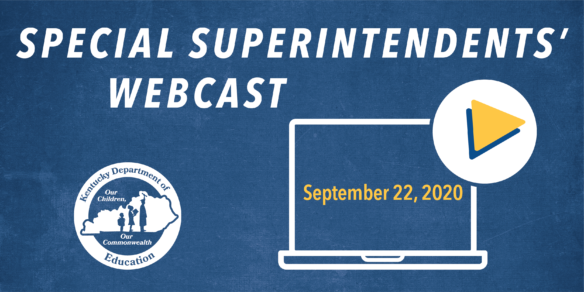
By Jim Gaines
jim.gaines@education.ky.gov
The Kentucky Department of Education (KDE) has submitted a draft proposal to the state outlining what services would be impacted and what challenges would result from a possible 8% budget cut.
On Sept. 3, State Budget Director John Hicks asked all state agencies to submit plans for an 8% reduction in the current fiscal year, which started July 1.
“That only impacts general funds, so that has nothing to do with federal funds,” said Robin Kinney, KDE associate commissioner in the Office of Finance and Operations, during the Sept. 22 Special Superintendents’ Webcast.
The Support Education Excellence in Kentucky (SEEK) funds – the main source of funding for K-12 education in the state – are exempted from the reduction, she said. SEEK, debt service and school districts’ local health insurance will be taken off the top before the 8% cut is calculated, Kinney said.
The request is a response to expected revenue declines resulting from the COVID-19 pandemic. The state is trying to plan ahead, but the final financial situation remains unknown, Kinney said.
When budget cuts are requested, each state department usually is asked to meet with the budget director and explain the likely impact, she said. KDE officials have asked for that meeting and will share further information as it becomes available, Kinney said.
COVID-19 Reporting and Guidance
The statewide online dashboard schools will use to file daily reports of COVID-19 infections and quarantines still is being tweaked and will go live Sept. 28, said Dr. Connie White, deputy commissioner of the Kentucky Department for Public Health (DPH).
Daily reports for the dashboard, which is intended to give school districts a real-time gauge of COVID-19 levels to assist in making local decisions about whether to reopen or continue in-person classes, must come from school staff or family members of the infected or quarantined person, White said. She already has heard of one case in which a student reported testing positive for COVID-19, but actually just didn’t want to go to school.
Lots of misinformation still is circulating about COVID-19 precautions in schools, she said, urging people to rely on the guidance in the Healthy at School flagship document.
“The flagship document is still the flagship document,” White said.
Commissioner of Education Jason E. Glass acknowledged that it will be problematic for schools to keep a 6-foot distance between students if all or most of them return for in-person classes.
Districts that do abide by the 6-foot distance guideline probably will need to offer hybrid classes, with some students learning remotely, Glass said. Later, Glass also noted that the Healthy at Schools guidance states that “If the physical space in the school does not allow for spacing students’ desks 6 feet apart, space desks as far away as possible. All desks should be arranged so students’ seats face the same directions.”
White emphasized that current guidance calls for social distancing and masks whenever possible, not one or the other. Nor should the caveat that allows less than 6 feet of distance be used as license to pack students into a classroom, she said.
Asked for recommendations on masking and distance for special education students, State Director of Special Education Gretta Hylton acknowledged those are difficult issues without blanket answers. Masks and distancing should not be avoided, but schools can consider allowing more space, adjusting staffing and positive reinforcement, she said.
Schools may email Hylton to discuss specific issues.
ATC Reopening Guidance
Guidance for reopening state-operated area technology centers (ATCs) to in-person classes has been released, including a four-color metric similar to what DPH provided Sept. 14 for school reopening in general, said David Horseman, KDE associate commissioner in the Office of Career and Technical Education.
Since most ATCs serve more than one school district, considerations for whether they can remain open for in-person classes depends on the level of positive COVID-19 tests in all districts that feed students into the ATC, he said.
That may mean some complex calculations, as feeder districts may vary widely in their rates of COVID-19 infection. If a feeder district is in the “red zone” – with a positive test rate of more than 25 per 100,000 people – that district will be asked not to send students for in-person classes at an ATC, Horseman said.
Sports Authority and Guidelines
At sporting events, the people exerting themselves – players and game officials – are allowed but not required to wear masks, said Julian Tackett, Kentucky High School Athletic Association (KHSAA) commissioner. That is already in KHSAA guidance on returning to fall sports, he said.
Guidance on bus trips, including mask-wearing during the bus trip, to sporting events is under KDE jurisdiction, but KHSAA could bar schools from hosting games if officials there are not making a good-faith effort to enforce COVID-19 guidelines, Tackett said.
But superintendents have willingly dealt with all lapses reported so far, and KHSAA’s philosophy is always to let local officials try to solve a problem before KHSAA steps in, he said.
Face Masks Available
Federal officials have allocated more than 2 million face masks for students and adults in Kentucky schools, which will be sent to the same local distribution centers as no-touch thermometers were in July, Kinney said.
“We’re just waiting for the green light to let you know when you can go and pick them up,” she said.
MORE INFO …
- Sept. 22 Special Superintendents’ Webcast
- KDE’s COVID-19 webpage
- KDE’s COVID-19 Reopening Guidance webpage
- Kentucky COVID-19 Hotline (800) 722-5725




Leave A Comment